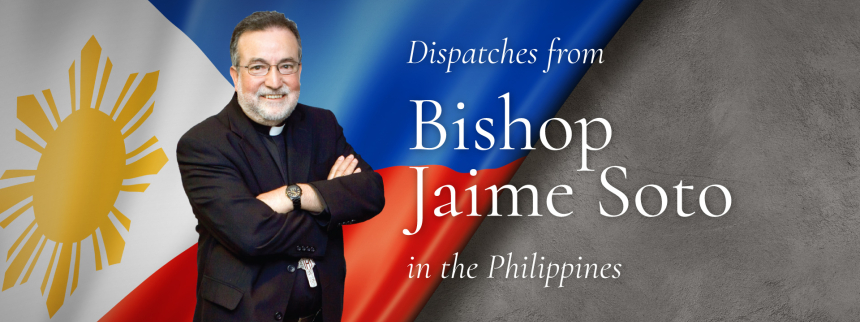
The pilgrims arrived in Lagazpi City to become acquainted with a chain of churches designated as heritage sites. The visit to Legazpi City and the surrounding region was overseen by a natural sentinel looming with quiet yet haunting beauty, the Mayon volcano. The last time it awoke was in 2009. During our stay, the giant cone wrapped itself in a moist blanket of clouds. Even its silence, though, commanded attention. The various heritage churches are some of the oldest in the Philippines. They form a circle around the volcano, so as we traveled we were always under the gaze of Mayon.
The tour of colonial stone churches included the Cagsawa ruins. Only a crumbling bell tower reminds everyone that on the site once stood a church. It had crumbled and was buried during an eruption in 1814. Sadly, many villagers had sought shelter in the church only to have it become their tomb.
Upon visiting the Cathedral of Legazpi, I noticed prominently set in the diocesan coat-of-arms was the image of the perfectly cylindrical cone of the volcano with a white plume rising from its crater. That such a natural menace would be at the center of the diocesan symbol points to one of the distinctive features of the Catholic community in the Philippines.
Large urban centers often create the illusion of a man-made world under our domain. Even when the cities seem chaotic, the presumption is that it can be managed with better laws, better technology, and better leaders. We can control our environment, so we think.
Living in the shadow of Mayon offers a daily reminder of powers and forces greater than ourselves. Human arrogance seems foolishly small on the volcanic plains surrounding Mayon. This technological age tempts us to think we can conform natural forces to our own image and likeness; anything to the contrary is only a temporary inconvenience waiting for a scientific fix. The primordial volcano set in the middle of the diocesan coat-of-arms suggests a different relationship with the natural world.
Also, set within the coat-of-arms are two red roses for Our Lady of Peñafrancia and a white lily symbolizing the Immaculate Conception. This seeming paradox speaks to the beautiful divine wisdom seen in the power of Mary’s humility: “Behold, I am the handmaid of the Lord. May it be done to me according to your word.” (Lk. 1.38) All of created nature, even human nature is at the mercy of God’s word. Mary’s humble disposition instructs all humanity of a new harmony with creation when we choose to place ourselves under the Lord’s merciful dominion.
The provocative coat-of-arms for the Diocese of Legazpi balances a volcano with the soft petals of roses and lilies. The two symbols for some maybe a contradiction. For the many communities living around Mayon, the symbols reflect the daily search to find one’s humble place in God’s creation as did the Virgin of Nazareth, singing with the unfathomable power of the Spirit: “The Mighty One has done great things for me, and holy is his name.” (Lk. 1.49)
Bishop Jaime Soto is currently on pilgrimage in the Philippines with a group of clergy and laity from the Diocese of Sacramento. Stay tuned to our News page for more of Bishop Soto's reflections from this pilgrimage.
Read more: First Dispatch - Second Dispatch - Third Dispatch - Fourth Dispatch - Fifth Dispatch

